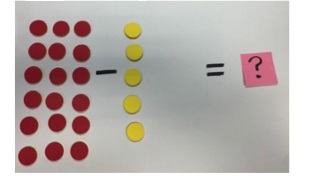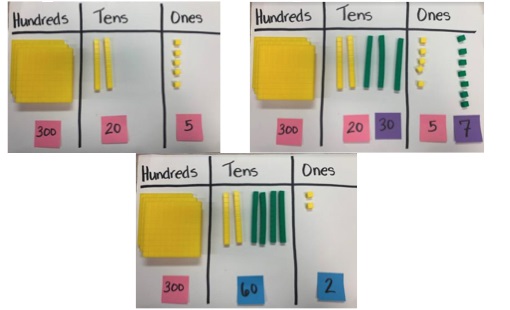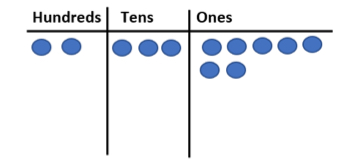Explore the addition of two whole numbers with sums up to 1,000. Explore the subtraction of a whole number from a whole number, each no larger than 1,000.
Examples
Example: The difference 612-17 can be found by rewriting it as 612-12-5 which is equivalent to 600-5 which is equivalent to 595.
Example: The difference 1,000-17 can be found by using a number line and making a “jump” of 10 from 1,000 to 990 and then 7 “jumps” of 1 to 983.
Clarifications
Clarification 1: Instruction includes the use of manipulatives, number lines, drawings or properties of operations or place value.
Clarification 2: Instruction focuses on composing and decomposing ones, tens and hundreds when needed.
Subject Area: Mathematics (B.E.S.T.)
Grade: 2
Strand: Number Sense and Operations
Date Adopted or Revised: 08/20
Status: State Board Approved
Benchmark Instructional Guide
Connecting Benchmarks/Horizontal Alignment
Terms from the K-12 Glossary
- Commutative property of addition
- Equation
- Expression
- Number line
Vertical Alignment
Previous Benchmarks
Next Benchmarks
Purpose and Instructional Strategies
The purpose of this benchmark is to extend the exploration of addition and subtraction of two whole numbers work from grade 1 to include a number set through 1,000. In grade 3, students will fluently add and subtract multi-digit whole numbers.
- Instruction includes the use of two- or three-digit numbers to add and subtract.
- Instruction includes the use of the commutative property of addition.
- It is not the expectation for students to use a standard algorithm. Instruction focuses on
strategies supported by manipulatives, number lines, base ten blocks, place value and
drawings.
- Instruction includes helping students understand that when adding it is sometimes
necessary to combine ones or tens and compose a new ten or new hundred.
- Instruction includes helping students understand that when subtracting it may be
necessary to decompose tens or hundreds and regroup ones or tens.
Common Misconceptions or Errors
- Students may try to apply properties of addition, such as the commutative property, to solve subtraction problems.
- Students may regroup but also include an additional, unnecessary ten or hundred.
- Students may incorrectly add or subtract because they have lost track of the value of
digits.
Strategies to Support Tiered Instruction
- Instruction includes examples of the commutative property of addition, and how it does not apply to the related facts for subtraction.
- For example, using two color counters have students represent the expression
13 + 5. Teacher asks, “What is the sum?” Then asks, “What are the related facts?” If students can identify the addition, but not the subtraction problems correctly, the teacher has students start with the total number of counters, 18.
“18 − 5 is what?” Students should respond with 13. Then the teacher asks, “What is another related fact?” If they try to do 5 − 18, have them start with 5 and take away 18. They will not be able to show the related fact with the numbers 18, 13 and 5. They will end up with negative numbers.

- Instruction includes the use of base ten blocks. Students may regroup ones and tens unnecessarily. Once students understand how to regroup you may find that they attempt to regroup when it is not needed. Using base ten blocks provide examples of expression with and without regrouping. When students are solving an addition problem and they have more than 10 ones or tens remind them that this is when they are to exchange for the next place. When subtracting remind the student that regrouping is only necessary when there is not enough base ten blocks to take away from the place value.

- Instruction includes the use of a place value chart to clarify understanding of the value of the digit to add or subtract. Using the chart will ensure the digit and its value is correct.
- For example, using the place value chart and base-ten blocks, students place the
number 325 into the chart using the base-ten blocks. Then, the teacher asks students to add or subtract 37 by either adding 37 or subtracting 37 base-ten blocks ensuring that students align the digits of the number in the correct place value.
Instructional Tasks
Instructional Task 1 (MTR.2.1)
A student represented the number 237, using counters, as a place value model shown below. Use the model below to find the value of 237 − 185.

Instructional Task 2 (MTR.4.1)
- Part A. Allow students to use various methods to find the sum of 581 and 72. Students may choose to count by 10s and 1s, use a number line, base ten blocks, a place value chart, or use the properties of operations.
- Part B. Have a discussion about the different methods students decided to use.
Instructional Items
Instructional Item 1
Find the value of the expression 454 + 219.
*The strategies, tasks and items included in the B1G-M are examples and should not be considered comprehensive.
Related Courses
Related Access Points
| Access Point Number |
Access Point Title |
| MA.2.NSO.2.AP.4 | Explore the addition of a two-digit and a single-digit whole number with sums up to 100. Explore the subtraction of a one-digit from a two-digit whole number. |
Related Resources
Formative Assessments
Lesson Plans
| Name |
Description |
| How Much Do We Need to Order? | Students are provided the task of determining the total number of students in Kindergarten, first, and second grades in their school. Students will develop a plan to collect the information. Students will create a table to represent the data and find the total number of students. |
| Cookie Contest | In this Model Eliciting Activity, MEA, students are asked to decide which factors are important in choosing the best cookie in a cookie contest. Students will take on the role of cookie critics to provide feedback to a teacher whose grade level is deciding which cookie to use for a fundraiser. They will rank order their choices from the best to worst cookie. Students will provide a detailed written explanation for how they decided to rank factors and their solution. They will show their work while adding up to 4 two-digit numbers to calculate the total number of votes.
Model Eliciting Activities, MEAs, are open-ended, interdisciplinary problem-solving activities that are meant to reveal students’ thinking about the concepts embedded in realistic situations. MEAs resemble engineering problems and encourage students to create solutions in the form of mathematical and scientific models. Students work in teams to apply their knowledge of science and mathematics to solve an open-ended problem, while considering constraints and tradeoffs. Students integrate their ELA skills into MEAs as they are asked to clearly document their thought process. MEAs follow a problem-based, student centered approach to learning, where students are encouraged to grapple with the problem while the teacher acts as a facilitator. To learn more about MEA’s visit: https://www.cpalms.org/cpalms/mea.aspx |
| Exploring Three-Digit Subtraction Strategies | Students will explore various strategies to learn how to subtract three-digit whole numbers when regrouping across one place value is required. |
| Place Value - 3 Digit Numbers | Students will decompose numbers by place value and represent them using concrete and pictorial models. |
Perspectives Video: Expert
| Name |
Description |
| B.E.S.T. Journey | What roles do exploration, procedural reliability, automaticity, and procedural fluency play in a student's journey through the B.E.S.T. benchmarks? Dr. Lawrence Gray explains the path through the B.E.S.T. mathematics benchmarks in this Expert Perspectives video. |
Problem-Solving Tasks
| Name |
Description |
| Comparisons 2 | The purpose of this task if for students to gain a better understanding of <,=,> with the help of number sentences.
</,=,> |
| How Many Days Until Summer Vacation? | The purpose of the task is to allow children an opportunity to subtract a three-digit number including a zero that requires regrouping. The solutions show how students can solve this problem before they have learned the traditional algorithm. |
Worksheets
Student Resources
Problem-Solving Tasks
| Name |
Description |
| Comparisons 2: | The purpose of this task if for students to gain a better understanding of <,=,> with the help of number sentences.
</,=,> |
| How Many Days Until Summer Vacation?: | The purpose of the task is to allow children an opportunity to subtract a three-digit number including a zero that requires regrouping. The solutions show how students can solve this problem before they have learned the traditional algorithm. |
Worksheet
Parent Resources
Problem-Solving Tasks
| Name |
Description |
| Comparisons 2: | The purpose of this task if for students to gain a better understanding of <,=,> with the help of number sentences.
</,=,> |
| How Many Days Until Summer Vacation?: | The purpose of the task is to allow children an opportunity to subtract a three-digit number including a zero that requires regrouping. The solutions show how students can solve this problem before they have learned the traditional algorithm. |
Worksheet



